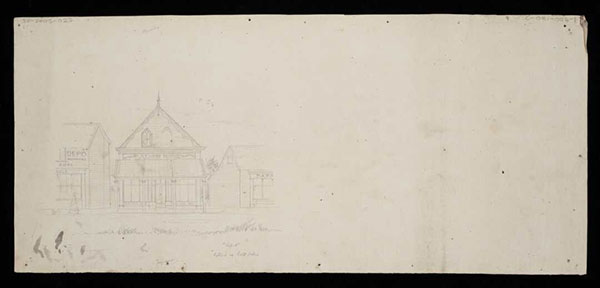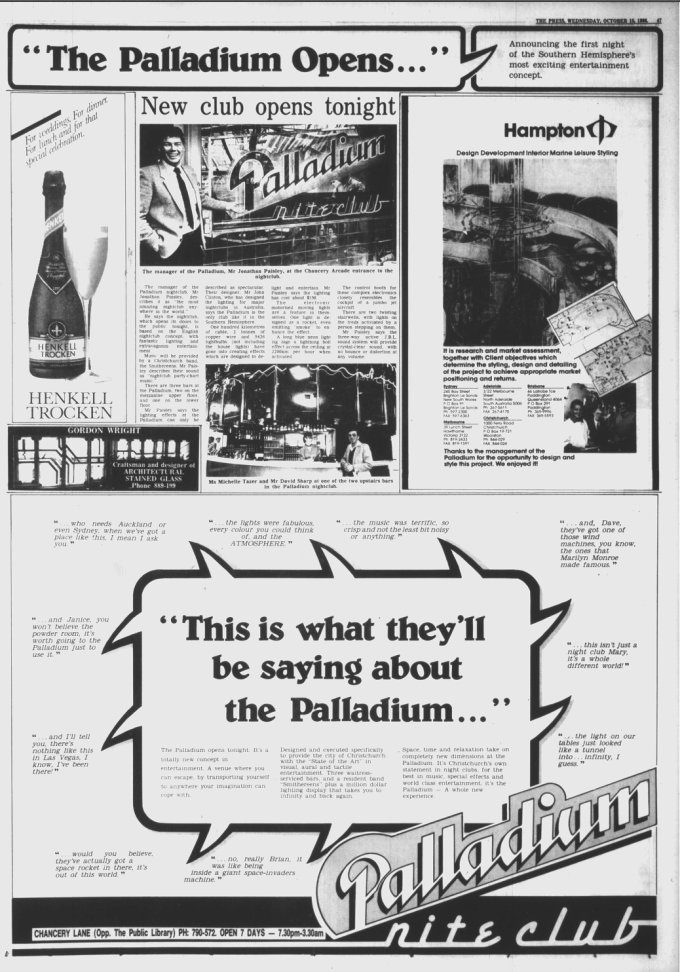The second in a series of posts uncovering the history of the city block that the new Christchurch convention centre, Te Pae is being built on.
Early days of Chancery Lane
Chancery Lane seems to have been around since Christchurch was "Ye Olde", though it didn't initially have a name. The pencil drawing below shows the embryonic lane running between Albion House and Papprill's tailor shop.
Albion House was established in 1860 and Papprill's was trading from Gloucester Street at a similar period.
Later, this thoroughfare provided a handy dandy shortcut for lazy Christchurch residents nipping between the Square, Gloucester Street, and beyond. One apocryphal tale is that lawyers on Hereford Street used the lane to get to the Magistrates' and Supreme courts but as most legal offices of the period were located on Gloucester street this doesn't quite stack up.
A private right-of-way, it was named "Chancery Lane" around 1881. George Humphrey of Fletcher, Humphreys & Co, importers of tea, sugar, wine and spirits took credit for the name. Humphrey had two street name plates sent from England and attached them to each end of the lane, christening it Chancery Lane. While the lane remained privately owned the Christchurch City Council had some responsibilities for lighting and maintenance.
Several early businesses set up on the lane - A.P. Osborn general engraver moved his business to No.1 Chancery Lane in 1882, Southern Cross Petroleum set up shop at No. 5 in 1883, Land and Estate Agent H.S. Piermont operated from No.7 Chancery Lane in 1883, later Cohen's loan office took on the lease for No.7.
1890s-1917: Bicycles, filth and chastity
The Lane became popular with cyclists, a Press headline from 1896 thundered "Bicycles in Chancery Lane" and further added that horses and even carts had been using this pedestrian only right-of-way. By 1899 The Star newspaper considered that the danger caused by cyclists had become acute, so much so that a police officer had been stationed there to take the names of offenders.
Ion Cowlishaw reminisced in a Star article (The Star, 2014 Oct, p.11) about his father, who worked for Garrick & Co solicitors in the 1890s, applying to the City Council to tether his horse on Chancery Lane during the day while he worked.
Clearly you needed your wits about you while strolling the highways and byways of Christchurch town. Today we watch out for Lime scooters but back then bicycles and horses (and horse poo) were a clear and present danger.
By the early 1900s Chancery Lane was a busy but rather dirty thoroughfare. Numerous, anonymous, letters to the newspapers lamented the filthy state of the lane and called for actions from the City Council.
In May 1904 the Council sent in an inspector who issued notices to the lane owners, and eventually a deal was hatched whereby the council would undertake maintenance of the lane at the cost of the private business owners.
Things must have improved by June 1906 when this delightful doggerel ditty appeared in the Star newspaper.
"There's a sweet little lane leading out of the Square, quite a right little, tight little, back-thoroughfare, it is narrow and strait (like the road up to Heaven), much crowded with lawyers each day at eleven, though for harps and haloes you'll seek all in vain, 'midst the angels who flourish near Chancery Lane"
Oh, but actually there was a sting in the second verse and scorn was heaped upon the Council for installation of a barrier and the laying of asphalt, opens a new window. The citizens of Christchurch were a tough crowd.
In January 1917 the Women's Social Hygiene Association was formed and set up offices in Chancery Lane. The association's aim was to promote "social purity and sex hygiene" and provide medical advice on, and treatment of, venereal diseases. The period of the First World War, opens a new window saw a marked increase in sexually transmitted disease. The Association's watchword was "Knowledge is power" and while it maintained that solutions to disease needed be actioned equally by both men and women, it fell someway short of modern liberated thinking by spurning prophylactics and instead embracing chastity!
1940s: Larrikinism, plain indecency and the lack of conveniences
By the 1940s Chancery Lane had again become rather down-at-heel.
A Press article from 1943 complained of a lack of public conveniences and the resulting nuisances. This is polite 1940s lingo for no loos=poos. The Gloucester Street end of the lane was considered the pooiest (not sure if that is a real word) and some "nuisances" had even found their way into letter-boxes. In 1944 the poo problem was raised again, the City Council agreed to investigate. Improved lighting and more public toilets, in locations previously used for air raid shelters, were recommended.
1960s: Chancery Arcade arrives
Chancery Arcade, an L-shaped addition to the lane, opened in December 1969.
An old building at 98 Gloucester Street was gutted to create an additional shopping precinct. The ground floor was converted into six new shops with access from Gloucester Street and all of it was given a Tudor theme, with brown beams, shingle facades and a large gas coaching lamp. Allegedly it was light and airy, especially the entrance into the Arcade from Chancery Lane which was double height and skylighted. The new shops included a fashion boutique called Image, Charles Lester Shoes of Fashion, Arcade Book, Toy and Floral Art Centre, Fry and Fletchers Jewellery and The Coachman Steakhouse.
1980s: Nite-clubs, fine dining and the smell of burnt sportsgear
A $2.5 million redevelopment of the lane began in 1981.
Phase one was the demolition of buildings on the west side of the lane including the Holy Cross Chapel. The lane was then enlarged to include a circular area, partially roofed with pedestrian bridges. The idea was to preserve the existing character of the lane with small, independent shops "doing their own thing". With a net retail space of 743 sq meters the venture was a joint development between Industrial Holdings and Waitaki NZ Refrigerating.
By February 1983 shops on the ground floor were nearly ready to open and the framework for a new building adjacent to the lane was being built. This new space was for retail, a restaurant and tavern.
The Grand Opening of The Chancery Tavern and Restaurant took place in October 1983. The interior decoration and design was undertaken by Hampton Studios, a Christchurch company, and it sounded simply splendid, "dusky pink and burgundy...brass, gold, smoked glass and mirrors" all it needed was a perm to scream 80s. The Press coverage for the opening considered it "lavish, dramatic and more in keeping with Hollywood or Las Vegas than a Antipodean provincial city". While the decor was worldly, a letter to The Press in November 1983 would suggest that the dress code and attitude of the bouncers was parochial. Josie Vidal complained that her friend was denied entry for wearing a denim jacket.
The next bit of Chancery Lane excitement, now in 1985, was a FIRE! It started in a discount outdoor clothing store on the corner of Gloucester Street and Chancery Lane. The air was filled with thick black smoke and the acrid smell of burning 1980s ski jackets. Quelle horreur! The flat above the shop, previously occupied by the Christchurch Media Club, was damaged but was in any case due for demolition. Sprinklers saved the fancy-pants Chancery Tavern and Restaurant.
The fire-damaged discount clothing store was demolished in August 1985 to make way for yet another shopping complex but even more excitingly, a cabaret. The cabaret site started development the same month and was helmed by Ian MacKenzie, owner of the Chancery Tavern. Like the Tavern his vision was for an upmarket, international venue that would feature the first in-house laser light show in the Southern Hemisphere, live cabaret acts and cater for 20-45 year-olds. The redeveloped Chancery Lane now had brand new adjacent buildings and all 80s designed to the max.
The Palladium nightclub opened on October 15th 1986. The first band to entertain was The Smithereens, a Christchurch band with a "nightclub party-chart" sound. Nightclub manager Jonathan Paisley skited about the 2 tonnes of copper wire, 100 km of cabling and 9426 light bulbs that had gone into the fitout. With a special effect control booth resembling a jumbo jet cockpit The Palladium also boasted a long, blue neon zig-zag lightning effect that moved across the ceiling at 2200 km per hour.
Take a moment to enjoy the creative ramblings from the advert above:
"... this isn't just a night club Mary, it's a whole different world"
"...and Dave, they've got one of those wind machines, you know, the ones that Marilyn Monroe made famous."
"...no, really Brian, it was like being inside a giant space-invader machine"
Oh my, chortle.
The Palladium, sometimes hilariously referred to as "The Getlaidium", closed in 2000 and re-emerged as The Dolls House, a strip club.
2000s: Outdated and damaged
Chancery Lane in more recent pre-quake times was still a very handy 80s-vibe thoroughfare and retail lane. In the 2000s internet cafes, ethnic food outlets, hairdressers and florists could all be found on the Lane, as well as Holy Cross Chapel and Catholic Diocese Shop.
The Arcade and neighbouring buildings were badly damaged in the quakes of 2011.
Chancery Lane and Arcade was demolished in March 2015 to make way for Te Pae, Christchurch's new convention centre.
Find out more
- Images of Chancery Lane and Arcade DigitalNZ
- Explore our Local History resources
- Find local history classes and events








Add a comment to: Goodbye Gloucester Street West: Chancery Lane